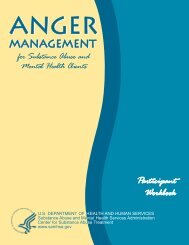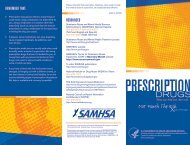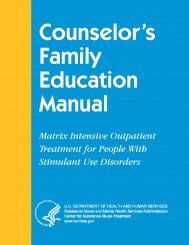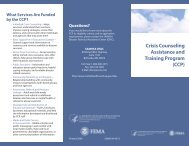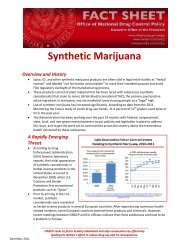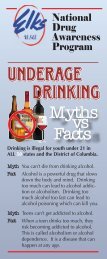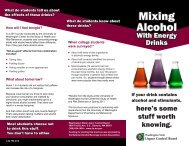Counselor's Manual for Relapse Prevention With Chemically ...
Counselor's Manual for Relapse Prevention With Chemically ...
Counselor's Manual for Relapse Prevention With Chemically ...
You also want an ePaper? Increase the reach of your titles
YUMPU automatically turns print PDFs into web optimized ePapers that Google loves.
Early Recovery Patients: These patients cannot get com<strong>for</strong>table in their recovery. When theyquit, they don't know how to change the way they live so they can enjoy being sober. Focus.Identify and change the things in the patients' lives that interfere with their desire to stay inrecovery. Most often, these are things associated with a using lifestyle (friends, family,neighborhood, etc.) that they don't want to give up.<strong>Relapse</strong> Patients: These patients get sober and clean, use AA or NA, and enjoy sobriety.However, something happens to make them begin to use again. Focus. Identify what kind ofproblems make them unhappy with recovery.Instructions. Have patients report the results of this exercise in their group. Have the group askeach patient what these results meanCwhat do they have to learn in order to recover? Encouragepatients to keep their answers in mind as they do the next few exercises, which focus on theirhistory.Exercise No. 3: Alcohol/Drug/Legal CalendarPurpose. The purpose of this exercise is <strong>for</strong> the patient to begin to get a clear picture of his or herhistory of drug or alcohol use and criminal behavior. The exercise paints this in<strong>for</strong>mation inpicture <strong>for</strong>m on a calendar. Most patients (especially those in early recovery) do not have a clearunderstanding of their own history and how events or situations in their lives cause other thingsto happen.Instructions. Ask patients to present their story (with a calendar) in group. If the patient is unableto do the exercise alone, help him or her in an individual counselor's session or help the patientdo the exercise on a blackboard in group. When the calendar is on the blackboard, the patient cancopy it into his or her workbook. Have the group ask patients what they learned from theexercise about their history that they previously did not realize.Exercise No. 4: <strong>Relapse</strong> Episode ListPurpose. The purpose of this exercise is to help patients identify things they did and did not do intrying to abstain from alcohol or drug use. By beginning to identify the causes of relapse,patients begin to learn how to refocus their thinking on what they can do to change.Instructions. Have each patient review the worksheets of this exercise in group. Ask the group toquestion what, if anything, changed after each relapse episode, what was similar each time, andif the patient can identify why attempts to stay clean and sober failed.Exercise No. 5: Summary of <strong>Relapse</strong> HistoryPurpose. This exercise helps patients to start to identify patterns that repeat themselves duringperiods of abstinence. It also helps patients understand that there is a series of events that happenbe<strong>for</strong>e they relapse. This understanding helps the patient start to see hope of stopping the pattern.



